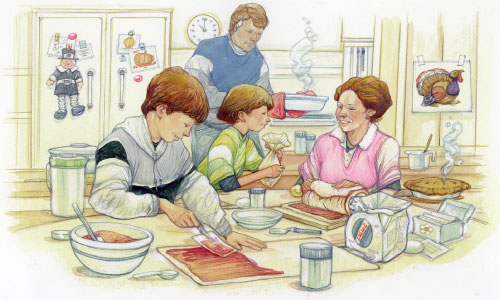
Savoring Holiday Memories Through Food Traditions
By Lynanne Lasota
Illustration by Joel Snyder
We may eat a variety of fast and prepared foods all year long, but when families gather during holidays, members look for customary favorites.
 |
About 25 years ago on a bustling holiday at my Polish grandparents’ house, Grandma and I prepared the feast in her tiny kitchen. I helped her put the final touches on pierogies, kielbasa and sauerkraut, city chicken, and several side dishes.
We walked back and forth from the kitchen to the dining room, placing dishes of delicious-smelling food on every available spot on the table. Suddenly, Grandma rushed back into the kitchen with a divided crystal tray, ordering me to fill it with pickles and peppers. I began to protest, “There’s no more room on the table.”
She put her hand up to shush me and said, “We have to have a relish tray!”
Last year, just before we sat down for our holiday meal, I handed my 10-year-old daughter, Rebecca, a similar divided crystal tray to fill with pickles and peppers. She started to protest, and I heard my departed grandmother’s words come out of my mouth: “We have to have a relish tray.”
My insistence was not about the pickles; it was about a holiday food tradition and the warm memories a relish tray brings in our family. Everyone joining us for the celebration knew the story of my loving Grandma and her fondness for relish trays.
“When these foods are absent from our lives, it is not so much the food we are missing, but the person or the feelings with which we associate it,” says Marsha K. Weaver, a county extension agent in Abilene, Kan., who has written numerous food-, family-, and consumer-related columns.
Memories
Meals give our families tradition and comforts that last through our lifetimes and beyond. The types of memories that seem to stick in people’s minds are the things done over and over again as a tradition rather than something elaborate on one occasion, says Weaver. She remembers her parents layering strips of sponge cake, chocolate, and cream to make a favorite German dessert. Today the tradition continues as her husband helps “lay the bricks” for their holiday meal. The taste takes Weaver back to her childhood.
“Smell and taste conjure up memories of holidays,” says Joan Ahlers, co-founder of Fresh Baby, a company that develops all-natural food products and recipes for children and toddlers for healthy eating. It has been proven, in more recent science, that these two senses leave lasting impressions on individuals as young as 18 months, adds Ahlers. She encourages parents to start building traditions while children are young.
Starting a tradition
For example, help each child find a recipe, shop for ingredients, and prepare the dish for the next holiday gathering, says Ahlers. A younger child can place mini carrots and ranch dressing in a bowl; an older child may want to make a no-bake cheesecake with a graham-cracker crust and whipping cream.
For those who don’t have culinary family traditions, it is never too late to start. “The best thing to do is pick something that everyone is going to like,” says Lynne Olver, a reference librarian in New Jersey with a passion for food history (www.foodtimeline.org).
One of the best recipes is something that involves everyone, especially the kids, says Olver. For example, maybe you have always bought pumpkin pie or chocolate pie. This time make it. Let everyone perform a task no matter how small. Participation gives ownership and pride to the meal.
And you don’t have to build a family tradition by spending six to eight hours in the kitchen, either, says Joan Ahlers.
Modifications
Marsha Weaver suggests modifying existing holiday food traditions by making the same dish in a quicker, simpler way, whereby you associate the memory rather than the rite. For example, lots of families used to make homemade noodles; now frozen noodles taste similar.
When Lynne Olver married, she learned that there were at least two ways to serve cranberry sauce. She continues her family’s tradition of homemade cranberries with mandarin oranges and sugar, while adding her husband’s preferred custom of opening both ends of a can to slide out a perfect cylinder of jellied cranberry for slicing.
“But I don’t believe in making things just because they have always been made,” says Olver. She remembers celery stuffed with cream cheese quickly arranged on a crystal dish. Not caring for this combination of flavors, she decided not to continue that tradition.
When Joan Ahlers started her own family, she found she spent all day in the kitchen during holidays; the kids didn’t like the food; and she missed out on the fun. Therefore, she created a food tradition different from her parents. “Now we do cheeseburgers and cut our own French fries, and that’s what works,” says Ahlers. It’s been a tradition for six years.
Meanwhile, Joan Ahlers’s sister, Cheryl Tallman, co-founder of Fresh Baby, prefers to stick with family tradition. Just as her parents did, she asks friends to come to a holiday open house each year.
Consistency and expectations
“Food traditions are particularly intriguing because they are some of the most persistent of traditions,” says Lynne Olver. Because people resist changing their food patterns, food often becomes closely tied to cultural identity.
When Olver moved to northern Kentucky from Long Island, N.Y., her family was invited to a friend’s house for the holidays. She remembers gasping to herself when she saw lasagna as the main dish. (Her family had always had turkey with all the fixings, but apparently for this family, lasagna was considered special holiday fare.)
Special foods remind people of home and family, becoming central to special occasions and rituals. Through food, families maintain a sense of generation and extension.
“Food is the most basic way of sharing and communing,” says Lynne Olver. “You show kindness to someone when you break bread with them.”
Lynanne Lasota is a freelance writer in Queen Creek, Ariz. Her last article for Scouting, "Bringing Up a Responsible Child," appeared in the September 2007 issue.
November - December 2007 Table of Contents
Copyright © 2007 by the Boy Scouts of America. All rights thereunder reserved; anything appearing in Scouting magazine or on its Web site may not be reprinted either wholly or in part without written permission. Because of freedom given authors, opinions may not reflect official concurrence.